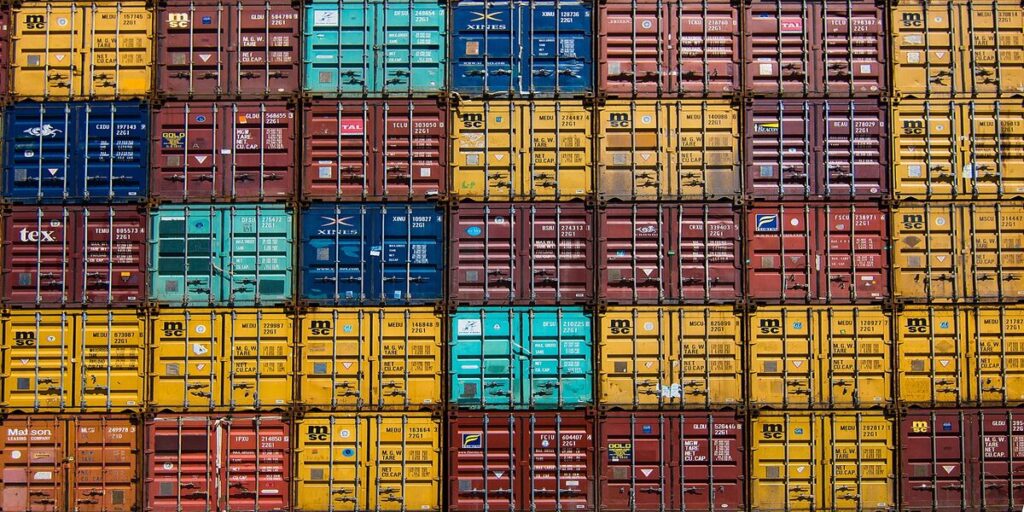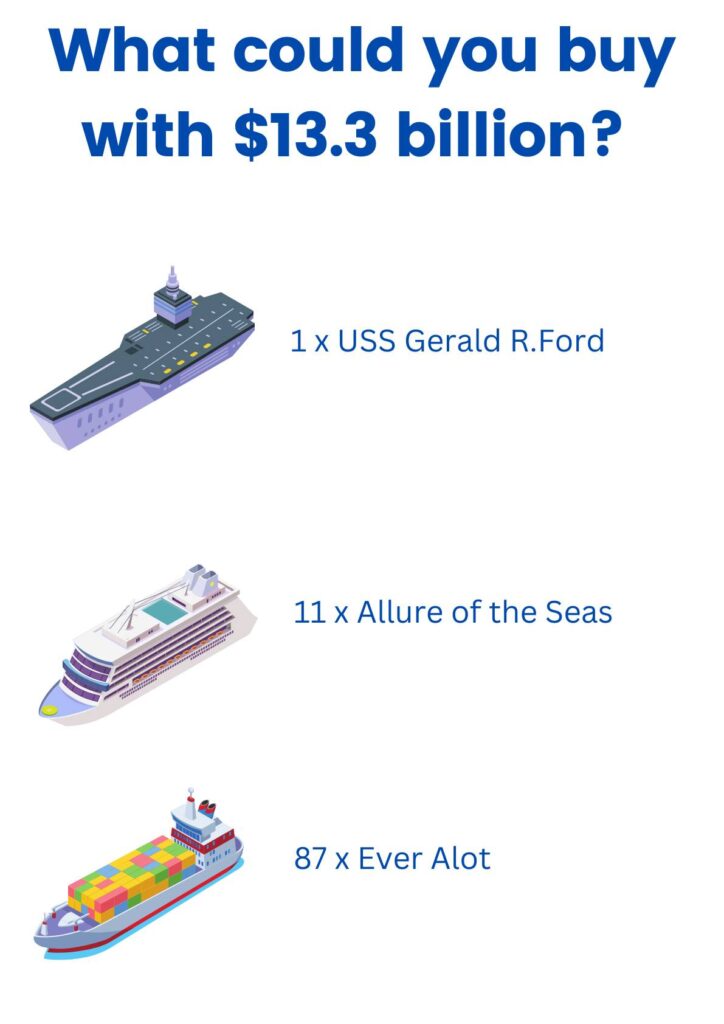Cargo Ships vs Aircraft Carriers: Which Is Bigger?
If you’ve ever seen an aircraft carrier up close, you will know that they are imposingly massive. The flared shape of their hull as you look up toward the flight deck makes them seem intimidating and impressive, and you might get the sense that nothing much bigger would even float!
However, you might be surprised to know that the world’s biggest cargo ship is significantly bigger than the world’s biggest aircraft carrier.
At 400 metres long and 61.5 metres wide, Evergreen Marine’s Ever Alot is the biggest container ship ever built.
Currently serving trade routes between Europe and the Far East, Ever Alot is 63 metres longer than the largest ever aircraft carrier, the USS Gerald R. Ford.
| USS Gerald R. Ford | Ever Alot | Allure of the Seas | |
|---|---|---|---|
| Length | 337m | 400m | 362m |
| Beam | 41m (waterline) 78m (flight deck) | 61.5m | 47m (waterline) 60.5m (maximum) |
| Personnel | 4,539 | 25 | 2,384 crew 5,492 passengers |
| Maximum speed | >30 knots | 22 knots | 22 knots |
| Build cost | $13.3 billion | $152 million | $1.2 billion |
There is one figure in the above table that stands out – even the biggest cargo ships can be run fairly efficiently on between 20-30 crew.
On cargo ships, merchant seafarers are trained to be multi-discipline experts, while the vast majority of the crew on cruise ships are housekeeping and galley staff. Governmental defence budgets allow warships to have as many crew as they need.
Is Ever Alot the biggest ship ever built?
At the time of writing, Ever Alot is the largest container ship ever built, although shipping companies frequently try to out-do each other by building ships marginally bigger than their competitors’ ships.
Shipping company MSC claims that its newest container ships are the biggest ever built. They are dimensionally identical to Ever Alot but can allegedly carry a few more containers than Ever Alot. However, because there is a lack of data on these vessels we are using Ever Alot, which can carry over 24,000 shipping containers, as our example.

It’s hard to imagine a ship bigger than Ever Alot. However, Ever Alot is not the biggest cargo ship ever built. There have been several oil tankers bigger than Ever Alot, and none bigger than the Seawise Giant.
When compared to the USS Gerald R. Ford, the Seawise Giant – also known during its lifetime as Oppama, Happy Giant, Jahre Viking, Knock Nevis, and Mont – is even more impressive.
Seawise Giant was capable of carrying 4.1 million barrels of oil and was in operation for 31 years before being scrapped in 2010.
| Seawise Giant | USS Gerald R. Ford | |
|---|---|---|
| Length | 458.45m | 337m |
| Beam | 68.6m | 41m (waterline) 78m (flight deck) |
| Displacement | 646,642 tonnes (loaded) | 88,000 tonnes |
Never mind the length and beam – just look at that difference in displacement!
The world’s biggest cruise ship
Royal Caribbean’s Allure of the Seas is the biggest cruise ship ever built. Although shorter in length than the Ever Alot, she is still longer, and wider – at the waterline – than the USS Gerald R. Ford.
Capable of carrying 2,200 crew and 6,780 passengers, Allure of the Seas is an impressive feat of naval architecture and engineering.
Of course, cruise ships and cargo ships are built for very different purposes than aircraft carriers.
So while you won’t find an ice skating rink, rock climbing walls, spas, or dozens of nightclubs and bars onboard USS Gerald R. Ford like you can on Allure of the Seas, she does have one incredible piece of kit that can’t be found on any of the biggest cargo or cruise ships – something than means that USS Gerald R. Ford won’t have to refuel for twenty years.
It’s not all about size – aircraft carriers are still incredible vessels
Although there may be longer and wider ships, the world’s biggest aircraft USS Gerald R. Ford holds a number of records in its own right.
She is not only the largest warship ever built; she is also the most expensive ship ever built.
The Congressional Research Service estimates the vessel’s build cost at $13.3 billion. This figure does not include several billion additional dollars spent on research and development.

Capable of travelling at over 30 knots, USS Gerald R. Ford is much faster than the largest container ships and cruise ships.
She can carry 4,539 personnel when sailing with a full air wing, and has something very special that Ever Alot and Allure of the Seas do not – her very own onboard nuclear power plant.

This onboard nuclear power plant means that USS Gerald R. Ford will be able to sail for an incredible 20-25 years before she has to stop to refuel.
Modern container ships can be expected to have a maximum working life of around 20-25 years. Given that USS Gerald R. Ford has replaced USS Enterprise, which served for 51 years, it is safe to say that the aircraft carrier should still be sailing for many years after today’s biggest cargo and cruise ships have been scrapped.
Why don’t they make aircraft carriers bigger?
In order for cargo ships and cruise ships to be deemed a success, they have to make a profit over their lifetime. After all, they are run as a business.
The desire of shipping companies to maximise cargo and/or passengers carried, along with the savings that can be made with regards to crew, maintenance, and fuel costs from having fewer but larger ships, has led to increasingly larger ships being built.
Aircraft carriers are not designed to make money. In fact, in commissioning a new aircraft carrier, a country’s government is resigning itself to spending billions of dollars that it will never see again.
Aircraft carriers are built to sizes which make sense for their operational purpose. They are built for combat survivability, speed, range, and endurance.
The United States’ newest fleet of carriers will be the biggest warships ever built. The fact that they are not as large as some cargo ships does not mean that warships are not significantly bigger than they used to be – there just isn’t much to be gained from spending extra billions to make them any bigger – for now.
